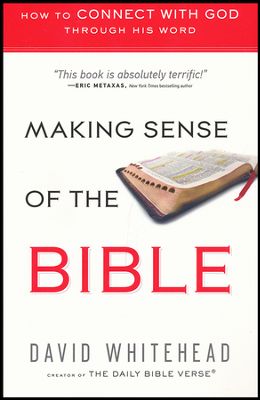Book Review: Making Sense of the Bible, by David Whitehead
December 4, 2014

December 4, 2014
David Whitehead, Making Sense of the Bible: How to Connect with God through His Word. Bethany House, 2014. 176 pps. $12.99.
The Bible is an immense book, comprised of hundreds of years of writing from a variety of different authors representing vastly different cultures, expressed in a wide range of genres and literary styles. It is also the authoritative Word of God and the primary means by which God has communicated his will to the church and to the world. This complex nature and importance of the Bible could make approaching the Bible a daunting task. David Whitehead—founder of the popular website, The Daily Bible Verse—has attempted to make this task more manageable through his book Making Sense of the Bible. I’ll discuss some of its strengths and weaknesses and conclude with remarks addressing whether its title lives up to its claim.
Whitehead’s book is commendable in several respects. The book’s readability and length (only 163 pages including appendices) is inviting to those who might not have a natural affinity for reading. The chapter on translations will most likely be the most helpful for one unfamiliar with the Bible. In that chapter, Whitehead discusses the necessity of multiple translations, the various types of translations that range from literal to paraphrase (along with their inherent strengths and difficulties), and a discussion outlining which translation might best suit the individual.
One of the book’s greatest strengths is Whitehead’s orienting principle of reading the Bible, which is “to get to know and interact with the God of the Bible” (11). Such a principle sets the appropriate agenda for the reader and frames not only the purpose of the Bible, but also why and how one should read it. Further, there is an entire chapter devoted to the importance of the heart of the reader, which is often overlooked in more academic introductions to the Bible.
Unfortunately, several fundamental problems undercut the intentions and heart behind the book. First, the organizing structure of the book is confusing. The chapters concerning the biblical content are ordered as follows: (4) “Abraham: Friend of God,” (5) “The Gospels,” (6) “The Epistles,” (7) “The Old Testament Narratives,” (8) “Moses: The Man Who Saw God Face-to-Face,” (9) “Poetry in the Bible,” (10) “David: A Man After God’s Own Heart,” (11) “The Prophetic Literature,” and (12) “Jesus: God With Us.” Regrettably, Whitehead provides no explanation or rationale for structuring the book along these lines. Why start with Abraham and then jump directly to the Gospels, and then address the Old Testament Narrative immediately after treating the Epistles? Without providing a more helpful (or intuitive) ordering of the material, the chapters seem disconnected to one another and arbitrarily thrown together.
Second, Whitehead fails to emphasize the overarching narrative of the Bible in order to connect all the pieces and unify the Old Testament and the New Testament. Only in the Epistles chapter is the overall biblical plot provided (72). Interestingly enough, the plot is mentioned in that chapter to demonstrate how the Epistles fit into the meta-narrative (or “big picture”) of the Bible, but it is not used again for the other sections. Why not use this at the beginning of the book and then subsequently fit each of the parts into the whole? It would seem that this would have been much more profitable to “making sense of the Bible.”
Third, the book suffers from oversimplification in several places, especially in regard to the various types of literature in the Bible. The book rightly includes chapters on Old Testament narratives, poetry, and prophecy. The problem is, however, that these categories of narrative, poetry, and prophecy are not presented as different types of literature but are simply classified as entire books. Therefore, the Pentateuch and the Former Prophets are treated strictly as narratives, though there are significant poetic interpretative sections throughout. Job and Ecclesiastes are treated as pure poetry, yet their narrative prologues and epilogues are essential to understanding the entire message of the book. It would have been more helpful to address the different types of literature and literary devices instead of over-generalizing books, running the risk of not adequately equipping the reader to deal with the various types of literature wherever they are found.
In spite of the noble goal of the book and some helpful chapters (“Why So Many Translations,” “The Gospels,” and “The Epistles”) the book ultimately falls short of delivering a consistently reliable resource for beginning readers to achieve a balanced grasp of the overall form and content of the Bible. Without a doubt, there is a monumental need for such books in our churches and the culture at large that help anyone and everyone get a confident grasp of Scripture. It is a great endeavor to undertake, and therefore it is all the more important for us to communicate and instruct with clarity, beauty, and simplicity.